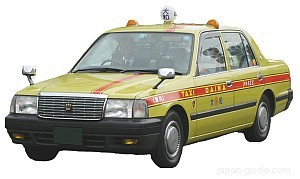Taxi

To the average cost-conscious traveler in Japan's large cities, taxis are an expensive and unnecessary alternative to the efficient public transportation, although they can provide comfort and convenience to those with luggage, mobility issues or a larger travel budget.
In smaller cities, the countryside and in Kyoto, where public transportation tends to be less convenient, taking a taxi from the nearest train station to your destination can be a good option. And if you travel in groups of three or more people, taxis can also be an economical option for shorter rides.
Furthermore, taxis are often the only way of getting around once trains and buses stop operating around midnight, resulting in a sudden increase in their demand, especially on Friday and Saturday nights, when lines at taxi stands at train stations are not uncommon.
Japan started to lifted its ban on ridesharing in 2024, but strict limitations remain on where, when and by whom such services can be offered. Consequently, rideshare apps in Japan can currently be used to hail predominantly taxis.
How to use a taxi
To hail a taxi, either go to a taxi stand (usually located in front of train stations) or flag one down at a location where it is safe for it to stop. A plate on the dashboard in the lower corner of the windshield indicates whether a taxi is vacant or not. Usually, a red plate indicates that the taxi is vacant, while a green plate indicates the opposite (see illustration below). During the night a light on the roof of a taxi can indicate that the taxi is vacant.

You can also call a taxi by phone, app or via your hotel reception; a small additional fee for calling a taxi may be charged. The best taxi app for international tourists in Japan is GO, boasting the largest number of taxis, the widest coverage and a user-friendly interface. Also easy to use - especially in urban areas - are Uber and DiDi, which in Japan also function mainly as taxi-hailing rather than ridesharing apps.
When you board a taxi, note that the vehicle's left rear door is opened and closed remotely by the driver. You are not supposed to open or close the door by yourself, except when using a different door. If you do not speak Japanese or if your destination is not well-known, it is recommended to provide your driver the address of your destination or point it out on a map, since the Japanese address system can be confusing even to local taxi drivers.
Many taxis accept payment by credit card, and an increasing number accept payment by IC card, such as Suica. Stickers on the door usually indicate accepted payment methods. When paying in cash, try to avoid paying small amounts with large bills. Tipping is not common.
In some regions, especially popular tourist areas, taxis are available for charter as sightseeing taxis with the taxi driver doubling as the tour guide. Although the language barrier might be a problem, in some areas there are taxi drivers with foreign language skills or sightseeing taxi services targeted specifically at foreign tourists. Sightseeing taxis typically cost around 20,000 yen for three hours, but a variety of plans is often available.
Taxi types and fares
Taxi drivers in Japan are generally trustworthy and will not try to take advantage of their clients. Licensed taxis can be recognized by their green license plates, as opposed to the white and yellow license plates of regular cars. In some places frequented by foreign tourists, such as Narita Airport, there are rare cases of unlicensed taxis showing up, which are better avoided. Fare calculation is almost always by the meter. The only exceptions are on a few popular tourist and airport routes where a predetermined, flat rate may be offered.
Taxi fares differ slightly according to the region, the company and the size of the vehicle. The common taxi cab in Japan seats up to four passengers (in addition to the driver) and has room for two suitcases. Larger taxis are available in smaller numbers and come with slightly higher fees. The commonly available "Toyota Japan Taxi" model (see photo at the top of this page) can accommodate a wheelchair instead of two passengers.
When using a standard four-passenger taxi, fares typically start around 400-750 yen for the first 1-2 kilometers and increase by around 80-100 yen for every additional 200-400 meters traveled. The cost also increases when the taxi is not moving or moving at a very low speed for a prolonged time. Late in the evening (10pm to 5am), rates are raised by typically 20 percent. If the taxi uses expressways, the expressway tolls are added to the fare. Many companies provide discounts on longer distances, typically 10 percent on trips over 9000 yen.

Questions? Ask in our forum.